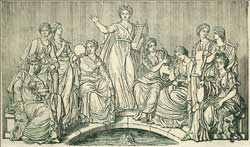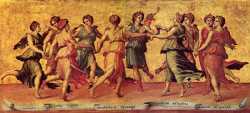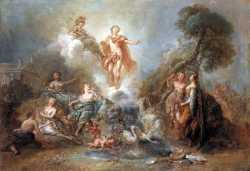Muse
The Muses, according to the earliest writers, were the inspiring goddesses of song, and, according to later noticus, divinities presiding over the different kinds of poetry, and over the arts and sciences. They were originally regarded as the nymphs of inspiring wells, near which they were worshiped, and bore different names in different places, until the Thraco-Boeotian worship of the nine Muses spread from Boeotia over other parts of Greece, and ultimately became generally established.1
The genealogy of the Muses is not the same in all writers. The most common notion was, that they were the daughters of Zeus and Mnemosyne, and born in Pieria, at the foot of Mount Olympus;2 but some call them the daughters of Uranus and Gaea,3 and others daughters of Pierus and a Pimpleian nymph, whom Cicero4 calls Antiope,5 or of Apollo, or of Zeus and Plusia, or of Zeus and Moneta, probably a mere translation of Mnemosyne or Mneme, whence they are called Mnemonides,6 or of Zeus and Athena,7 or lastly of Aether and Gaea.8Eupheme is called the nurse of the Muses, and at the foot of Mount Helicon her statue stood beside that of Linus.9
With regard to the number of the Muses, we are informed that originally three were worshiped on Mount Helicon in Boeotia, namely, Melete (meditation), Mneme (memory), and Aoede (song); and their worship and names are said to have been first introduced by Ephialtes and Otus.10 Three were also recognized at Sicyon, where one of them bore the name of Polymatheia,11 and at Delphi, where their names were identical with those of the lowest, middle, and highest chord of the lyre, viz. Nete, Mese, and Hypate,12 or Cephisso, Apollonis, and Borysthenis, which names characterize them as the daughters of Apollo.13
As daughters of Zeus and Plusia we find mention of four Muses, viz. Thelxinoë (the heart delighting), Aoede (song), Arche (beginning), and Melete.14 Some accounts, again, in which they are called daughters of Pierus, mention seven Muses, viz. Neilo, Tritone, Asopo, Heptapora, Achelois, Tipoplo, and Rhodia,15 and others, lastly, mention eight, which is also said to have been the number recognized at Athens.16 At length, however, the number nine appears to have become established in all Greece.
Homer sometimes mentions Musa only in the singular, and sometimes Musae in the plural, and once only17 he speaks of nine Muses, though without mentioning any of their names. Hesiod18 is the first that states the names of all the nine, and these nine names henceforth became established. They are Clio, Euterpe, Thalia, Melpomene, Terpsichore, Erato, Polyhymnia, Urania, and Calliope. Plutarch19 states that in some places all nine were designated by the common name Mneiae, i.e. Remembrances.
If we now inquire into the notions entertained about the nature and character of the Muses, we find that, in the Homeric poems, they are the goddesses of song and poetry, and live in Olympus.20 There they sing the festive songs at the repasts of the immortals,21 and at the funeral of Patroclus they sing lamentations.22 The power which we find most frequently assigned to them, is that of bringing before the mind of the mortal poet the events which he has to relate; and that of conferring upon him the gift of song, and of giving gracefulness to what he utters.23
There seems to be no reason for doubting that the earliest poets in their invocation of the Muse or Muses were perfectly sincere, and that they actually believed in their being inspired by the goddesses; but in later times among the Greeks and the Romans, as well as in our own days, the invocation of the Muses is a mere formal imitation of the early poets. Thamyris, who presumed to excel the Muses, was deprived by them of the gift they had bestowed on him, and punished with blindness.24 The Sirens, who likewise ventured upon a contest with them, were deprived of the feathers of their wings, and the Muses themselves put them on as an ornament;25 and the nine daughters of Pierus, who presumed to rival the Muses, were metamorphosed into birds.26 As poets and bards derived their power from them, they are frequently called either their disciples or sons.27 Thus Linus is called a son of Amphimarus and Urania,28 or of Apollo and Calliope, or Terpsichore;29Hyacinthus a son of Pierus and Clio;30Orpheus a son of Calliope or Clio, and Thamyris a son of Erato.
These and a few others are the cases in which the Muses are described as mothers; but the more general idea was, that, like other nymphs, they were virgin divinities. Being goddesses of song, they are naturally connected with Apollo, the god of the lyre, who like them instructs the bards, and is mentioned along with them even by Homer.31 In later times Apollo is placed in very close connection with the Muses, for he is described as the leader of the choir of the Muses by the surname Musagetes (Μουσαγέτης).32
A further feature in the character of the Muses is their prophetic power, which belongs to them, partly because they were regarded as inspiring nymphs, and partly because of their connection with the prophetic god of Delphi. Hence, they instructed, for example, Aristaeus in the art of prophecy.33 That dancing, too, was one of the occupations of the Muses, may be inferred from the close connection existing among the Greeks between music, poetry, and dancing. As the inspiring nymphs loved to dwell on Mount Helicon, they were naturally associated with Dionysus and dramatic poetry, and hence they are described as the companions, playmates, or nurses of Dionysus.
The worship of the Muses points originally to Thrace and Pieria about Mount Olympus, from whence it was introduced into Boeotia, in such a manner that the names of mountains, grottoes, and wells, connected with their worship, were likewise transferred from the north to the south. Near Mount Helicon, Ephialtes and Otus are said to have offered the first sacrifices to them; and in the same place there was a sanctuary with their statues, the sacred wells Aganippe and Hippocrene, and on Mount Leibethrion, which is connected with Helicon, there was a sacred grotto of the Muses.34 Pierus, a Macedonian, is said to have been the first who introduced the worship of the nine Muses, from Thrace to Thespiae, at the foot of Mount Helicon.35 There they had a temple and statues, and the Thespians celebrated a solemn festival of the Muses on Mount Helicon, called Mouseia (Μουσεῖα).36 Mount Parnassus was likewise sacred to them, with the Castalian spring, near which they had a temple.37

From Boeotia, which thus became the focus of the worship of the nine Muses, it afterwards spread into the adjacent and more distant parts of Greece. Thus we find at Athens a temple of the Muses in the Academy;38 at Sparta sacrifices were offered to them before fighting a battle;39 at Troezen, where their worship had been introduced by Ardalus, sacrifices were offered to them conjointly with Hypnos, the god of sleep;40 at Corinth, Pirene, the spring of Pegasus, was sacred to them;41 at Rome they had an altar in common with Heracles, who was also regarded as Musagetes, and they possessed a temple at Ambracia adorned with their statues.42 The sacrifices offered to them consisted of libations of water or milk, and of honey.43
The various surnames by which they are designated by the poets are for the most part derived from the places which were sacred to them or in which they were worshiped, while some are descriptive of the sweetness of their songs.
In the most ancient works of art we find only three Muses, and their attributes are musical instruments, such as the flute, the lyre, or the barbiton. Later artists gave to each of the nine sisters different attributes as well as different attitudes, of which we here add a brief account.
- Calliope, the Muse of epic poetry, appears with a tablet and stylus, and sometimes with a roll of paper;
- Clio, the Muse of history, appears in a sitting attitude, with an open roll of paper, or an open chest of books;
- Euterpe, the Muse of lyric poetry, with a flute;
- Melpomene, the Muse of tragedy, with a tragic mask, the club of Heracles, or a sword, her head is surrounded with vine leaves, and she wears the cothurnus;
- Terpsichore, the Muse of choral dance and song, appears with the lyre and the plectrum;
- Erato, the Muse of erotic poetry and mimic imitation, sometimes, also, has the lyre;
- Polymnia, or Polyhymnia, the Muse of the sublime hymn, usually appears without any attribute, in a pensive or meditating attitude;
- Urania, the Muse of astronomy, with a staff pointing to a globe;
- Thalia, the Muse of comedy and of merry or idyllic poetry, appears with the comic mask, a shepherd's staff, or a wreath of ivy.
❧
The word music is derived from μουσική (mousike), "art of the Muses." Similarly, museum comes from μουσεῖον (mouseion), "‘seat of the Muses."
Iconography
On the François vase the Muses appear without their attributes, with the exception of the flute-playing Calliope. Later they are depicted with the specific attributes. In some representations the Muses are seen with feathers on their heads, alluding to their contest with the Sirens.
Various statues of the Muses from antiquity have been preserved, such as in the collection of the Vatican Museum. There is also a relief from Mantinea (style of Praxiteles, fourth century BCE) and the relief by Archelaus of Priene (ca. 125 BCE) that depicts the apotheosis of Homer, and the Helicon with the Muses.
References
Notes
- Respecting the Muses conceived as nymphs see Scholiast on Theocritus, vii, 92; Hesychius s.v. Νύμφη; Stephanus of Byzantium, s.v. Τόρρηβος; Servius on Virgil's Eclogues vii, 21.
- Hesiod. Theogony, 52 ff., 915; Homer. Iliad ii, 491; Odyssey i, 10; Pseudo-Apollodorus. The Library i, 3.1.
- Scholiast on Pindar's Nemean Odes iii, 16; Pausanias. Description of Greece ix, 29.2; Diodorus Siculus, iv, 7; Arnobius. Adversus Nationes iii, 37.
- On the Nature of the Gods iii, 21.
- Hesiod's Works and Days, 6; Pausanias. Description of Greece l.c.
- Ovid. Metamorphoses v, 268.
- Isid. Orig, iii, 14.
- Hyginus. Fabulae: Preface.
- Pausanias. Description of Greece ix, 29.3.
- ibid. ix, 29.1 ff.
- Plutarch. Symposiacs ix, 14.
- Plutarch, l.c.
- Tzetzes, l.c.; Arnobius, iii, 37; Servius on Virgil's Eclogues vii, 21; Diodorus Siculus, iv, 7.
- Cicero, Arnobius, Tzetzes, ll.cc.; Servius on Virgil's Aeneid i, 12.
- Tzetzes, Arnobius, ll.cc.
- Arnobius, l.c.; Servius on Virgil's Aeneid i, 12; Plato. Republic, 116.
- Odyssey xxiv, 60.
- Theogony, 77 ff.
- l.c.
- Iliad ii, 484.
- Iliad i, 604; Hymn to Pythian Apollo, 11.
- Odyssey xxiv, 60; comp. Pindar. Isthmian Odes viii, 126.
- Iliad ii, 484, 491, 761; Odyssey i, 1; viii, 63 ff., 481, 488; Eustathius on Homer, p. 259.
- Homer. Iliad ii, 594 ff.; Pseudo-Apollodorus. The Library i, 3.3.
- Eustathius on Homer, p. 85.
- Antoninus Liberalis 9; Ovid. Metamorphoses v, 300 ff.
- Homer. Odyssey viii, 481; Hymn to Selene, 20; Hesiod. Theogony, 22; Pindar. Nemean Odes iii.; Servius on Virgil's Georgics ii, 476.
- Pausanias. Description of Greece ix, 29.3.
- Pseudo-Apollodorus. The Library i, 3.2.
- ibid. i, 3.3.
- Iliad i, 603, Odyssey viii, 488.
- Diodorus Siculus, i, 18.
- Apollonius Rhodius. Argonautica ii, 512.
- Pausanias. Description of Greece ix, 29.1 ff., 30.1, 31.3; Strabo. Geography pp. 410, 471; Servius on Virgil's Eclogues x, 11.
- Pausanias. Description of Greece ix, 29.2.
- Pausanias. Description of Greece ix, 27.4, 31.3; Pindar. Fragments, 656 (ed. Boeckh); Diodorus Siculus, xvii, 16.
- Plutarch. On the Pythian Resonses, 17.
- Pausanias. Description of Greece i, 30.2.
- ibid. iii, 17.5.
- ibid. iii, 31.4 ff.
- Persius. The Satire: Prologue, 4; Statius. Silvae, ii, 7. 1.
- Plutarch. Quaestiones Romanae, 59; Pliny the Elder. Naturalis Historia xxxv, 36.
- Scholiast on Sophocles' Oedipus Colonus, 100; Servius on Virgil's Eclogues vii, 21.
Sources
- Aken, Dr. A.R.A. van. (1961). Elseviers Mythologische Encyclopedie. Amsterdam: Elsevier.
- Smith, William. (1870). Dictionary of Greek and Roman Biography and Mythology. London: Taylor, Walton, and Maberly.
This article incorporates text from Dictionary of Greek and Roman Biography and Mythology (1870) by William Smith, which is in the public domain.

